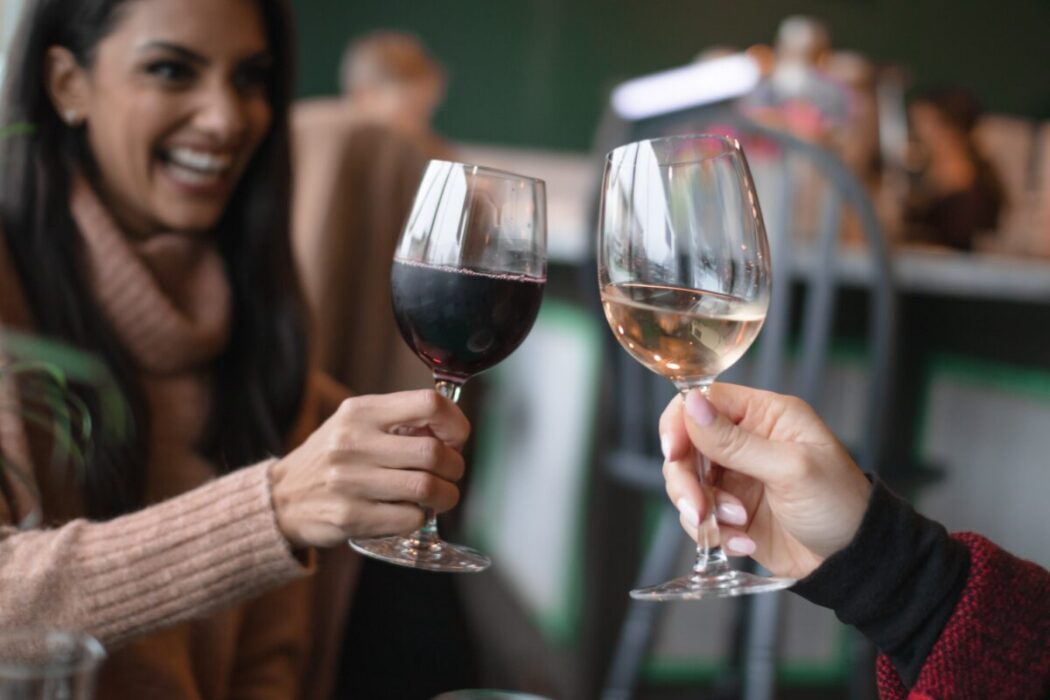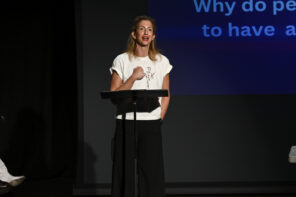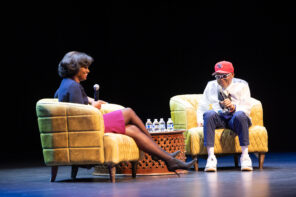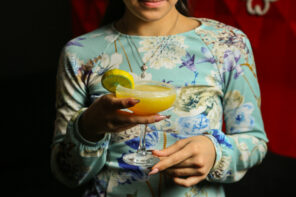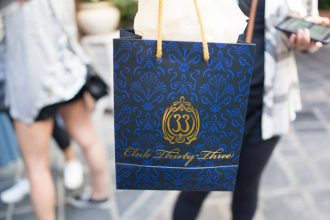When it comes to the art of winemaking, talking with three young winemakers opens your eyes to the mindset and ideology of a new generation.
When you drink a glass of wine, what you’re sipping tells a story, unfolding the grape variety, the place it’s from and the choices of the winemaker. The winemaker decides when to pick the grapes; whether the grapes are fermented in stainless steel, cement or oak with native or commercial yeasts; the type of vessel the wine is aged in; and whether it is filtered or fined. There are so many stylistic choices a winemaker makes that affect the final product.
Sometimes winemakers make wine for a few brands at once or oversee their own labels while working with other wineries. Some do consulting work on the side. The process is challenging, no matter how you slice it. Harvest takes place at the same time at every vineyard, so winemakers have to manage picking grapes for several different wines around the same time. Each brand has its own identity and style, and while wine expresses where it is from, it typically also expresses the winemaker.
We spoke with three young entrepreneurial women who are juggling multiple roles in the industry.
[columns_row width=”half”] [column]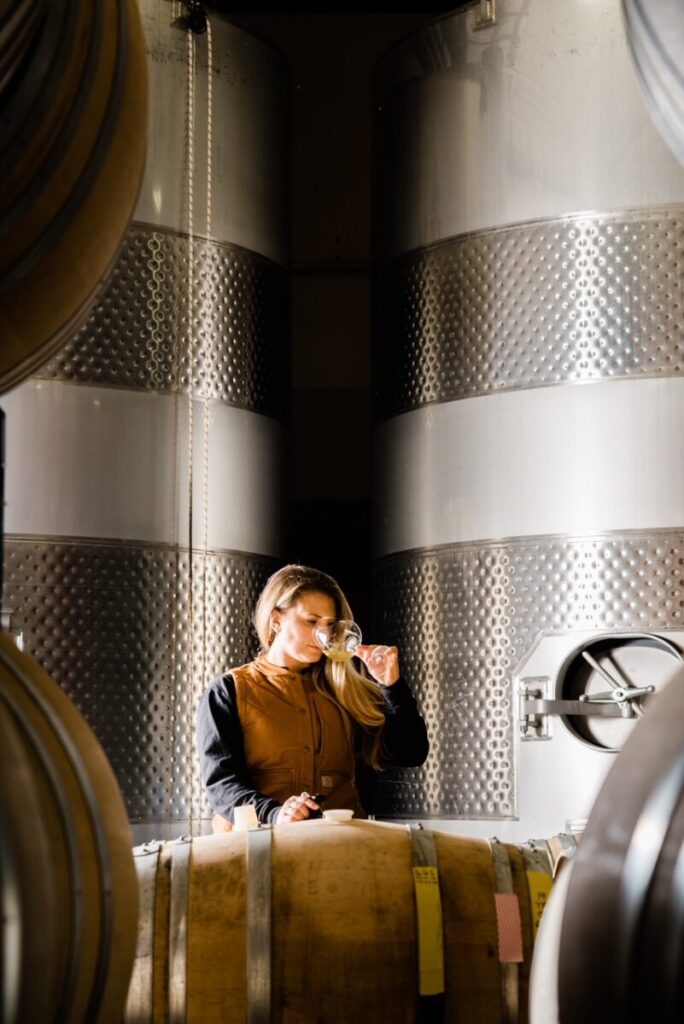 [/column]
[column]
[/column]
[column]
[/column] [/columns_row]
Erica Stancliff, Sonoma, California
Erica Stancliff grew up in Forestville, the heart of the Russian River Valley. Her parents and numerous friends and neighbors were home winemakers. When Stancliff’s mother started working for famed winemaker Paul Hobbs, Stancliff realized how amazing wine could be—and that it was a serious endeavor. While in high school, she walked a vineyard with Hobbs and watched his attention to the vines. Asking him questions, she saw the passion behind winemaking. “That’s when the light bulb went off for me,” she says. “That’s when I knew I wanted to pursue my career in the wine industry and make something with my hands that was a labor of love.”
Katy Wilson, Sonoma, California
Katy Wilson was raised in a small agricultural town in California, where her parents owned a hay-hauling business and a walnut orchard. Wilson grew up immersed in the world of agriculture and was never afraid to get her hands dirty, whether it be driving tractors or pruning walnut trees. It was no surprise when she set her sights on a degree in Agricultural Business at Cal Poly in San Luis Obispo. During her freshman year, the professor in her Agricultural Business 101 class introduced students to different areas of agriculture. When she started talking about wine, Wilson knew right away that making wine was the path she wanted to pursue. “Wine was the perfect combination of farming, science and creativity. So, at 18 years old, I took on Wine & Viticulture as a second major and set on the path to making wine my career,” she says.

Gretchen Voelcker, Santa Ynez, California
Raised on the East Coast, Gretchen Voelcker was first intrigued by the wine industry while living in Brussels during her senior year of high school. Her mother organized a private tasting experience for her family in Bordeaux, and they visited many premiere wineries, including Lynch Bages. Voelcker, drawn to the balance of science and creativity, participated in a wine class in which the host introduced them to Bacchanal, a game that teaches students to detect different scents in wine. “I really could not identify even the simplest and most common scents, like roses, which prompted me into years of smelling and tasting anything I could get my hands on,” Voelcker says. “This day culminated with a tasting of two different 1985 wines, one Left Bank and one Right Bank, which just completely opened my eyes to what wine could become and the poetry behind it.”
Who has been a mentor to you in the wine industry?
Erica Stancliff (ES): Paul Hobbs was my greatest mentor in how he guided me through college and starting my career. But a lesser-known one who I really look up to and attribute to being a woman winemaker is Carol Shelton. Carol has been a family friend for years, and watching her drive, tenacity and skill is what really made me feel like, as a woman, I could succeed in this industry. Carol is a force to be reckoned with and is an amazing person.
Katy Wilson (KW): I have had so many amazing winemakers in my life that I have learned from and who have helped me out along the way. I have also had a few wonderful people in my life who are not winemakers but who I really look up to and who have taught me so much about moving forward in my career and running a business. The one person I would like to mention is my great-grandmother, who was such a great influence in my life that I named my winery, LaRue Wines, after her. Veona LaRue lived to be 98 years old, so I knew her very well. She always told me that I could do whatever I wanted in life and not to let anyone tell me otherwise. I have kept her spirit of hard work and determination with me in every step of my career.
Gretchen Voelcker (GV): My earliest mentor who really helped me start my brand and find my creative voice in winemaking is Ryan Roark of Roark Wine Co. He introduced me to the Garagiste movement and natural winemaking. He gave me the opportunity to start Luna Hart after offering me a ton of Sauvignon Blanc from a vineyard he was leasing as part of my compensation and gave me a lot of guidance, as well as the space to start my brand. My other big mentor was Adrienne St. John from Rideau Vineyard. She was the second winemaker that I worked under. She helped me to establish strict cleanliness protocols in the cellar, which I find imperative to my style, and encouraged experimentation in our winemaking to really learn about different varietals. My best friend, Tymari Lore, who is the general manager at Folded Hills Winery, is also one of my biggest mentors. She consistently encourages and helps me to hone the business and sales side of my brand.

What is your approach to making wine?
ES: I always say, “When you have gold coming into the winery, it’s hard not to make gold.” I try to allow the vineyard sites I select to speak through the glass; my job as winemaker is to give them a voice that isn’t overshadowed by invasive winemaking practices (fining, or additions, heavy oak use). I want my style to be respective of each site so they can keep their unique characteristics and the fruit can shine.
KW: I like to let the vineyards speak for themselves, so my intention is to be as hands off as possible. I do this in a thoughtful way. I am very careful about when and how much I expose my wines to oxygen through fermentation and aging. I also top off my barrels often and pay close attention to how the wines are tasting through the aging process. I love that no vintage is the same. I strive to showcase maximum vineyard expression, allowing for the unique nuances of each vintage to shine through, while simultaneously allowing for my style to shine through as well.
GV: I aim to give a more refined portrayal of the varietals I work with by taking a minimal interference approach, using native fermentation and making unfined and unfiltered wines from some intentionally farmed vineyards. This approach stems from working at Rideau. My first two harvests were full of trials with yeast vs. non-inoculated fermentations [natural fermentations], and I always preferred the non-inoculated. This then blossomed in the summer of 2014, when I worked with Ryan Roark at Faith Vineyard in Los Olivos District. He showed me the world of Garagiste, minimal interference winemaking, and taught me a lot about organic and holistic farming approaches. This experience also gave me the chance to try it myself with one ton of Sauvignon Blanc for the 2014 harvest, which was the beginning of Luna Hart Wines. This passion was fueled even further with my experience in the Central Otago in New Zealand, where my peers really ignited my passion in winemaking and the natural wine movement.

How do you separate each winery in your winemaking?
ES: Just like how I like to respect each vineyard site, the same goes for the vision of the brand and what the owner/brand or client would like. Each style is directly related to how the vineyard shows itself but the style in which the brand would like to represent. Each one is approached differently with that in mind.
KW: I approach my consulting in the same way that I approach all winemaking. I strive to showcase the vineyards and the nuances of the vintage. Because of this, I do not worry about trying to make one winery’s wines different from another. They are already going to be different, because I do not make any two wines the exact same way. I am adapting to the vineyard and the season with all of my wines.
I also work closely with the owners of the wineries in expressing each winery’s unique style. Small changes such as the percentage of new oak used or the amount of whole cluster in a fermentation can differentiate the style of each winery. For Reeve Wines and Smith Story Wine Cellars, owners Noah Dorrance and Eric Story (respectively) are also the winemakers and I am the consulting winemaker. Working together and bringing two palates to the winemaking team brings a different aspect to the wines and their style as well.
GV: With Luna Hart, I focus on particular varieties and specific vineyards that I have built relationships with over the years. With Piazza Family wines, I am really looking to showcase our particular sites. We see the brands as sister brands and showcase them together to lift each other up. They complement each other well.
What is the biggest challenge to juggling multiple brands? And what is the biggest joy?
ES: The biggest challenge is feeling like I am dedicating enough attention and enthusiasm to each. I like to throw myself into my work and feel each deserve so much attention—yet I’m only one person! The biggest joy is the wine and seeing my clients’ faces when they are happy. Making a product I and my business partners are proud of is what makes this so enjoyable for me. Wine is joy, and it should translate in the glass!
KW: The biggest challenge in making wines for multiple brands is scheduling and logistics. Everything from checking vineyards to scheduling harvest to bottling becomes more complicated when you are dealing with multiple wineries. I am very hands on with the wineries that I work with, so it is definitely a balancing act.
I think that the greatest joy of working with multiple wineries is the diversity of wines that I get to make. For my own wine, I make only Pinot Noir and Chardonnay from a specific sliver of the Sonoma Coast. When I am making wines for other wineries, I am working with vineyards all over Sonoma County and Mendocino County. I am also working with 20 different varieties. It is so exciting to be able to make such a diversity of wines.
GV: The best thing is that I get to work with so many different varietals, which is exciting and continues to push me to grow. That may also be the biggest challenge as well—having to represent so many varietals to the best of my ability and market them as all unique but wonderful.
How do you find balance between the projects and life?
ES: So, you’re saying my life has to be balanced like I try to make my wines? I love working, and I know I work a lot and extremely hard, but having a supportive partner and time management outside of harvest are how I try to find balance. I make time by going to the gym before work, seeing my horses as much as possible after work or on the weekends and caffeinating myself regularly to survive the long days.
KW: There is no sugarcoating the fact that managing work/life balance can be difficult. When you are working on something that you have created–both with LaRue and my consulting business–you want to do everything in your power to achieve your fullest potential at all times, even if it means working odd hours or fitting in meals in between drives to the vineyards. However, I do consciously schedule time to do non-wine-industry-related activities to keep from burning out. I love what I do, and it often does not feel like work, but it is important to take a break now and then. This is something that I have to constantly remind myself.
This past year, I got married to my amazing fiancée, who now works with me at LaRue full-time, and we are welcoming our first child in early June. We have been busy mapping out how the second half of the year will look and making all the necessary arrangements that make sense for our family so that I can carry on the work cadence that I am used to while also soaking in all the joys of becoming a first-time parent.
GV: I am so fortunate to have such a supportive work and home team. Piazza Family Wines owners Ron and Nancy are phenomenal partners, and they not only support me personally but also professionally, and in return, I support all of Piazza Wines. I have always been a very active person, and when I am not engaged in the winery or vineyard activities, I am spending my time outdoors working on my personal garden and hiking the Santa Barbara mountains and beaches. I am fortunate to be able to continue my life-long passion as a horseman with training my yearling filly, Ebony, at Piazza or working on mounted archery with my horse Marco!

Where in the world do your favorite wines originate?
ES: Champagne all day, every day and forever. Second would be Sonoma County for the wide array of wines and varietals that are produced here.
KW: I always have a hard time with questions about my favorite wines. It is too hard to choose! I love exploring wines from all over the world. The great thing about wine is that you can continue to learn about and taste new wines for the rest of your life.
GV: As one may guess from my portfolio, I draw most of my inspiration from the Loire Valley in France and Austria. I love how truly diverse Grüner Veltliner is throughout Austria as well as throughout the world.
[columns_row width=”third”] [column]


More About the Winemakers
Erica Stancliff is a consulting winemaker for a number of brands. She is the winemaker for her family winery, Trombetta Family Wines (1200 cases), Pfendler Vineyards (500 cases), Stressed Vines (300-500 cases), O’Connell Vineyards (500 cases) and Estreet Cru (1000 cases across a different brands), as well as enologist for Browne Family wines, which includes Cirq Estate and CHEV. Stancliff is also the current president of the Board of the Petaluma Gap Winegrowers Alliance, which includes 30 wineries, 30+ growers and 30+ business associates. Based in Sonoma, she works primarily with Pinot Noir and Chardonnay, but as a consulting winemaker, she’s excited about working again with Bordeaux varietals and some red wine blends.
Katy Wilson celebrates her twelfth year as owner of and winemaker for LaRue Wines (500 cases), an ultra-premium label featuring elegant and restrained Pinot Noir and Chardonnay from the Sonoma Coast. On the consulting side, she makes wine for Anaba Wines (8,000 cases), Reeve Wines (5,000 cases) and Smith Story Wine Cellars (2,000 cases), all artisan wineries based in Sonoma, where she annually makes more than 60 different wines across 18 varieties, sourced from more than 50 vineyards across Sonoma and Mendocino counties.
Gretchen Voelcker received her degree in Plant Science from UC-Santa Cruz in 2012. Shortly after graduation, she moved to Santa Barbara, where she worked as the assistant winemaker at Rideau Vineyard. In 2014, Voelcker began tinkering on the side to make wines from her favorite grapes and relaunched under the label Luna Hart in 2017. Luna Hart (300 cases) is her personal project focusing on Grüner Veltliner, Sauvignon Blanc, Syrah and Cabernet Franc. In addition, Voelcker is helping Ron and Nancy Piazza launch their new label, Piazza Family Wines (800 cases), focusing on their estate vineyards, Sta. Rita Hills in Mount Carmel and BellaVista Vineyard in Ballard Canyon, which is where Voelcker hosts private tastings of all the wines.

This story, Young Women Winemakers Offer A Unique Perspective, was originally published in SheVille and has been republished here with permission.

